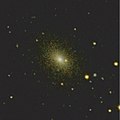| NGC 3923 | |
|---|---|
 NGC 3923 by imaged by the Hubble Space Telescope | |
| Observation data (J2000 epoch) | |
| Constellation | Hydra |
| Right ascension | 11h 51m 01.7118s [1] |
| Declination | −28° 48′ 21.386″ [1] |
| Redshift | 0.005801±0.00003 [1] |
| Heliocentric radial velocity | 1739±9 km/s [1] |
| Distance | 71 ± 23 Mly (21.6 ± 7.0 Mpc) [1] |
| Apparent magnitude (V) | 9.6 |
| Characteristics | |
| Type | E4–5 [1] |
| Size | ~264,700 ly (81.16 kpc) (estimated) [1] |
| Apparent size (V) | 5.9′ × 3.9′ [1] |
| Notable features | Shell galaxy |
| Other designations | |
| ESO 440- G 017, AM 1148-283, MCG -05-28-012, PGC 37061 [1] | |
NGC 3923 is an elliptical galaxy located in the constellation Hydra. It is located at a distance of about 90 million light years from Earth, which, given its apparent dimensions, means that NGC 3923 is about 155,000 light years across. NGC 3923 is an example of a shell galaxy where the stars in its halo are arranged in layers. It has more than twenty shells. [2] It was discovered by William Herschel on March 7, 1791.

